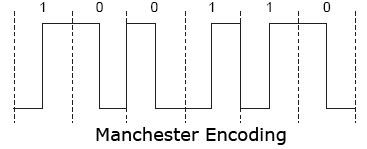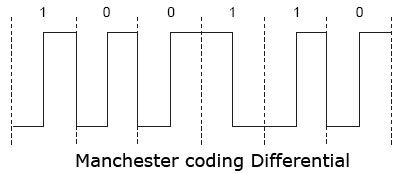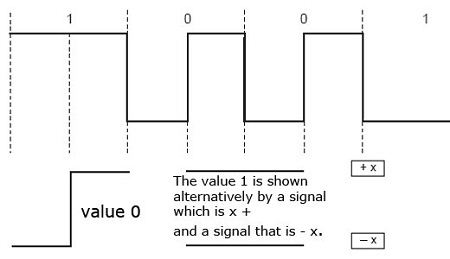How to encode the digital signal is an important function of coupler communication. This main function is to adapt the signals transmission channel. In the case of local networks, the transmission rate is tens or hundreds of megabits per second. Therefore, the choice of representation Physical data is important. To perform the synchronization bit, that is to say, to ensure that each bit is read at the right time, you need a minimum of transitions are made to extract the clock signal.
The coding used in most LANs, especially in networks Ethernet is the Manchester coding or differential release his Manchester. Coding Manchester, also known as Biphase-L (biphase-level), is illustrated in FIG. There is always a transition per bit, such that the values of the signal pass nonstop from positive to negative. This transition is performed middle of the range. In the figure, 0 is indicated by a transition from above bottom, while the one is indicated by a transition from bottom to top. The figure shows 100110 after the Manchester encoded. The signal starts with a negative polarity and passes to a positive polarity in the middle of the interval. This shift from a negative polarity a positive polarity is called a rising edge. 1 is represented by an edge 0 and the amount by a falling edge.

Differential Manchester coding takes into account the previous bit, as illustrated in figure. Bit 0 is represented by a change of polarity at the beginning of a time bit. Bit 1 is characterized by the absence of polarity change at the beginning of a bit time. This encoding has the advantage of being independent of polarity.

The block coding is another method widely used in LANs. The principle General of this coding is to transform an n-bit word to a m-bit word, hence its other name coding nB / mB. Due to technological constraints, n generally chosen values are 1, 4 or 8.
The principle of coding 1B / 2B, or CMI coding (Codec Mode Indication), is illustrated in figure. A signal is transmitted on two clock times. 1 is indicated by a level Continuous high and continuous level bottom turn. A value of 0 starts with a level continuous low on the first clock signal and then continues with a continuous high level on the second clock signal. More 1001 shown in Fig request so eight clock time to encode four bits. The first two clock time transport bit 1, which corresponds to a continuous high level. After the two 00-bit, value 1 is transported by a continuous low level. The following 1 is transported by a level up continuously. This coding is easy to implement, but has the disadvantage that the signal occupies a double bandwidth.

The nB / mB codes have interesting properties. One can use their particularities to detect transmission errors, getting banned words or represent specific sequences, such as delimiters of frames or tokens. For example, in putting two on top levels in the previous example we would not represent 11 but after a forbidden word. The error checks can be made by checking that the encoding rules are not violated. One can recognize a particular sequence by violation of polarity, that is to say, by the failure of alternating low–level highlevel. The figure provides an example.

 Dinesh Thakur holds an B.C.A, MCDBA, MCSD certifications. Dinesh authors the hugely popular
Dinesh Thakur holds an B.C.A, MCDBA, MCSD certifications. Dinesh authors the hugely popular